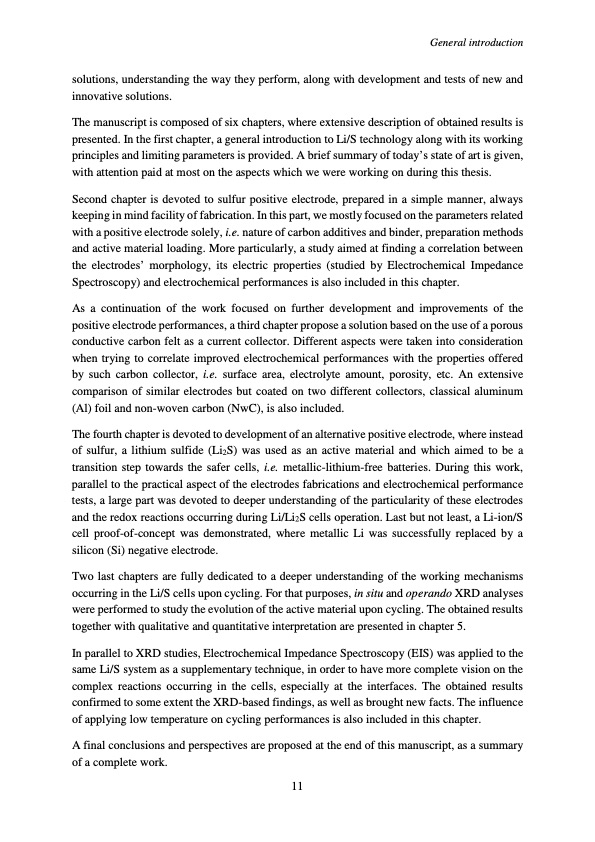
PDF Publication Title:
Text from PDF Page: 015
solutions, understanding the way they perform, along with development and tests of new and innovative solutions. The manuscript is composed of six chapters, where extensive description of obtained results is presented. In the first chapter, a general introduction to Li/S technology along with its working principles and limiting parameters is provided. A brief summary of today’s state of art is given, with attention paid at most on the aspects which we were working on during this thesis. Second chapter is devoted to sulfur positive electrode, prepared in a simple manner, always keeping in mind facility of fabrication. In this part, we mostly focused on the parameters related with a positive electrode solely, i.e. nature of carbon additives and binder, preparation methods and active material loading. More particularly, a study aimed at finding a correlation between the electrodes’ morphology, its electric properties (studied by Electrochemical Impedance Spectroscopy) and electrochemical performances is also included in this chapter. As a continuation of the work focused on further development and improvements of the positive electrode performances, a third chapter propose a solution based on the use of a porous conductive carbon felt as a current collector. Different aspects were taken into consideration when trying to correlate improved electrochemical performances with the properties offered by such carbon collector, i.e. surface area, electrolyte amount, porosity, etc. An extensive comparison of similar electrodes but coated on two different collectors, classical aluminum (Al) foil and non-woven carbon (NwC), is also included. The fourth chapter is devoted to development of an alternative positive electrode, where instead of sulfur, a lithium sulfide (Li2S) was used as an active material and which aimed to be a transition step towards the safer cells, i.e. metallic-lithium-free batteries. During this work, parallel to the practical aspect of the electrodes fabrications and electrochemical performance tests, a large part was devoted to deeper understanding of the particularity of these electrodes and the redox reactions occurring during Li/Li2S cells operation. Last but not least, a Li-ion/S cell proof-of-concept was demonstrated, where metallic Li was successfully replaced by a silicon (Si) negative electrode. Two last chapters are fully dedicated to a deeper understanding of the working mechanisms occurring in the Li/S cells upon cycling. For that purposes, in situ and operando XRD analyses were performed to study the evolution of the active material upon cycling. The obtained results together with qualitative and quantitative interpretation are presented in chapter 5. In parallel to XRD studies, Electrochemical Impedance Spectroscopy (EIS) was applied to the same Li/S system as a supplementary technique, in order to have more complete vision on the complex reactions occurring in the cells, especially at the interfaces. The obtained results confirmed to some extent the XRD-based findings, as well as brought new facts. The influence of applying low temperature on cycling performances is also included in this chapter. A final conclusions and perspectives are proposed at the end of this manuscript, as a summary of a complete work. 11 General introductionPDF Image | Accumulateur Lithium Soufre

PDF Search Title:
Accumulateur Lithium SoufreOriginal File Name Searched:
WALUS_2015_archivage.pdfDIY PDF Search: Google It | Yahoo | Bing
Sulfur Deposition on Carbon Nanofibers using Supercritical CO2 Sulfur Deposition on Carbon Nanofibers using Supercritical CO2. Gamma sulfur also known as mother of pearl sulfur and nacreous sulfur... More Info
CO2 Organic Rankine Cycle Experimenter Platform The supercritical CO2 phase change system is both a heat pump and organic rankine cycle which can be used for those purposes and as a supercritical extractor for advanced subcritical and supercritical extraction technology. Uses include producing nanoparticles, precious metal CO2 extraction, lithium battery recycling, and other applications... More Info
| CONTACT TEL: 608-238-6001 Email: greg@infinityturbine.com | RSS | AMP |